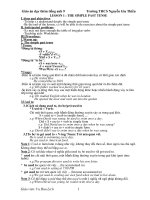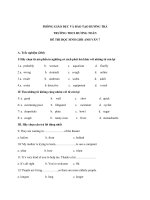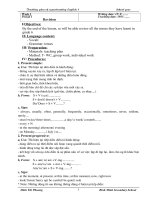Giáo án tiếng anh lớp 7 soạn theo chương trình VNEN mới tham khảo (17)
Bạn đang xem bản rút gọn của tài liệu. Xem và tải ngay bản đầy đủ của tài liệu tại đây (157.81 KB, 7 trang )
11/1/2015 English 7
Week 22
Period 63
UNIT 7: TRAFFIC
Lesson 7: Looking back
A. Aims and objectives.
1. Knowledge: By the end of the lesson, Ss will be able to:
- Recycle the language from the previous lessons in Unit 7 and link it with unit topics.
- Consolidate and apply what they have learnt in Unit 7 through various activities and
exercises.
2. Skills: Speaking and writing.
3. Attitude: Sts must have good attitude towards doing exercises.
4. Competencies: Self-assessment.
B. Preparation
- Teaching aids: Textbook pictures
C. Procedures
Time Teacher's activities Students' activities
7' Warm up Grouping 1 P14
? Study the picture in 1 P13
? Write the meaning below each sign
individually.
? Work in groups and put the signs into
correct boxes.
- Teacher monitors and gets feedback
Key:
1. Traffic lights 2. School
ahead
3. Hospital ahead 4. Cycle lane
5. Parking 6. No parking
7. Left turn only 7. No cycling
Prohibition signs: 6,8
Warning signs: 1,2,7
Information signs: 3,4,5
8' I. Vocabulary
Word web
? Work in pairs. Write the names of
means of transport in the word web.
? Then draw lines joining the correct
verbs to the transport.
- Teacher corrects the mistakes and
adds some if need be.
Suggestion:
- bicycle, motorbike, car, bus, taxi, train,
plane, boat, ship
- Ride a bicycle/ a motorbike
- Drive a car
- Fly a plane
- Sail on/in a boat
- Get on/ get off a bus/ a train/ a bike/ a
motorbike
15' II. Grammar
1. Used to
a. Revision
? How do you use "used to"?
? Write the form of "used to" in (+/ -/ ?)
sentences.
- We use "used to" to describe an action or a
state that happened regularly in the past but
does not happen at present.
(+) S + used to + Vinf
(-) S + didn't use to + Vinf
b. Ex3. P14
? Change the sentences according to the
prompts in brackets.
? Work in pairs.
- Have some students write on the
board.
? Give comments.
- Teacher give corrections
c. Ex4 P14
? Work individually to write sentences
using the cues given.
? Work in pairs and swap your writing.
- Have some students read the
sentences aloud.
- Teacher gives correction.
(?) Did + S + use to + vinf ?
Ex3. P14
Key:
1. Did you use to go to school on foot?
2. Mr Van didn't use to ride his motorbike
dangerously.
3. Did the streets use to be cleaner and more
peaceful?
4. I used to go out on Sundays.
5. They didn't use to go on holiday together.
Ex4. P14
Key:
1. It is over 100 km from my home-town to
Ho Chi Minh City.
2. It is about 25 km to my grandparents'
house.
3. I used to ride a small bike in the yard
before my flat.
4. There used to be a bus station in the city
centre, but it was/ has been moved to the
suburbs.
5. Children must learn about road safety
before they are allowed to ride a bike on the
road.
10’ III. Communication
? Read the questions and answers
aloud.
? Match the questions 1-6 with the
answers a-f.
? Role play the questions and answers.
Then write in the notebooks.
- Teacher gets feedback.
Ex5 P14
1. b
2. a
3. e
4. d
5. f
6. c
3' IV. Consolidation
- Ask students to complete the self-
assessment.
- Identify any difficulties and weak ares
and provide further practice if need be.
? Sum up the main content of the lesson
- Answer individually
- Remember
2' V. Homework
- Learn by heart vocabulary and
structures.
- Prepare: Unit 8: Getting started
- Listen and take note the assignments
Period 64
Unit 8: FILMS
Lesson 1: Getting started
A. Aims and objectives:
1. Knowledge: By the end of the lesson, Ss will be able to extend and practice vocabulary
related to the topic “Films” through the dialogue between Duong and Mai about films.
2. Skills: Listening and reading.
3. Attitude: Sts must have good attitude towards watching films.
4. Competencies: Use language to ask and answer about films
B. Content:
- Vocab: vocabulary related to films
- Grammar: Suggestion, adverb clause with although.
C. Preparation:
- Materials: Ss’ books, text books, posters, tape and radio
D. Procedures:
Teacher’s activities Students’ activities
4' I. Warm up : Brainstorming
- Elicit any information ss know about
films by asking about types of film they
know, the latest films they have seen ,
their favorite films and film stars
- Use the pictures in textbook to
introduce the new lesson
6'
II. The new lesson
* Teaching new words
- Teacher elicits the words from
students.
- Follow the seven steps of teching
vocab.
* Checking: What and where
- horror film
(n)
phim kinh
dị
-frightening
(n)
khủng khiếp
- comedy
(n)
hài kịch
- critic
(n)
nhà phê bình
-thriller
(n)
phim ly kỳ, giật
gân
-documentary
(n)
phim tài liệu
-animation
(n)
phim hoạt hình
-plot
(n)
cốt truyện
-review
(n)
bài phê bình
-stunt
(n)
trò nguy hiểm
-star
(v)
đóng vai chính
14' 1.Listen and read
- T uses the pictures in the textbook to
set the scene and asks some -Listen to teacher and answer
7'
5'
questions:
Where are Phong and his sister Mai ?
What are they talking about?
- Ask ss to listen and read the
conversation.
-Play the recording twice
-Ask ss to read the conversation aloud in
pairs.
a. Answer the questions
-Ask ss to work individually to choose
the correct answer to the questions.
- Ask ss to read aloud the answers.
- T confirms the correct answers
b. Find the questions in the
conversation that ask about Coconut
Crazy
-Run through the phrases
- Ask ss to work in pairs to look at the
conversation and find the questions.
- Call on some pairs to read aloud and
some ss to write on the board.
-Ask ss to listen, check and repeat the
questions
2. Matching the types of films with
their definitions. Then listen, check
and repeat
- Run through the phrases and
sentences
- Ask ss to work individually to match
the types of films with their definitions.
- Play the recording for ss to check
their answers then ask them to repeat.
- Correct their pronunciation if
necessary
- Help ss translate them into
Vietnamese
3a. Think of a film. Fill in the blank
- Have ss work dependently , filling in
the table with the information of the
films they have seen recently. Remind
them to use the words and phrases they
have learnt in 2 and from the
conversation.
questions
- Practice the conversation in
pairs
-Work individually to choose the
correct answer to the questions.
* Answer key :
1-B
2-A
3-A
4-C
5-B
-Work in pairs to find the
questions.
* Key :
a. What kind of films is it?
b. What does it stars?
c.What is it about?
d.What do critics say about it?
-Listen and repeat the questions
-Work individually to match the
types of films with their
definitions.
Key:
1-d 5-b
2-f 6-e
3-a 7-h
4-c 8-g
- Work dependently , filling in the
b. In pairs, interview each other and
try to guess the film
-Ask ss to study the example.
-T models with a good student.
-Ask ss to work in pairs
- Go around to help weak students
- Call on some pairs to practise
table with the information of the
films they have seen recently.
- Possible answer:
Mr. Bean
Type of film: hilarious
Actor: Rowan Atkinson
Plot: Mr Bean's funny action
Reviews: very funny and relaxed.
-Work in pairs to interview
3'
3'
III. Consolidation
- Sum up the lesson
IV. Homework
- Learn by heart all the new words and
structures.
-Guide ss how to do Ex B1,2
- Prepare: A closer look 1
Answer
- Take note
________________________________________
Period 65
Unit 8: FILMS
Lesson 2: A closer look 1
A. Aims and objectives:
1. Knowledge: By the end of the lesson, Ss will be able to:
-use the lexical items related to the topic films
- pronounce correctly the -ed ending in verbs
2. Skills: Listening and reading.
3. Attitude: Sts must have good attitude towards watching films.
4. Competencies: Know how to use Ing- ADJ and Ed-ADj, know how to use the past
simple tense
B. Preparation:
- Materials: Ss’ books, text books, posters, tape and radio
C. Procedures:
Time Teacher’s activities Students’ activities
5' I. Warm up
-Organize the game Guessing
- Ask ss to write the name of the film they
like on a piece of paper and keep secret.
- T call one student to stand in front of the
class and ask him/her to give some clues .
Others ask Yes- No questions to ask and
guess the name of the film.
- Take turn to play the game
- Take part tin the game
- Introduce the new lesson
7'
II.The new lesson
Vocabulary
T elicits Vocab from ss
hilarious (adj) vui nhộn, hài
hước
gripping (adj) thú vị
scary (adj) sợ hãi
moving (adj) xúc động
violent (n) có nhiều cảnh bạo
lực
entertaining (n) thú vị, làm hài lòng
disappointed (adj) thất vọng
terrified (n) cảm thấy khiếp sợ
20' A. Vocabulary
1. Add some adjectives
- Run through the adjectives that are often
used to describe films.
- Ask ss to work in pairs to add some
more.
Complete the sentences using the
adjectives in thre list
- Ask ss to work independently to
complete the sentences
- Call on some ss to write the answers on
the board.
- Confirm the correct answers
Remember
-Ask ss to study the Remember box. Draw ss'
attentionto the difference in use and meaning
between -ed and -ing adjectives by analyzing
the examples in the Remember box. Then
ask ss to give examples.
- Remind ss that they should use a good
dictionary to check theit meaning and use
2.Complete the table with the -ed and -ing
forms of the adjectives.
- Ask ss to work individually to complete
the table.
- Let ss read aloud and some ss write on
the board.
- Translate each pair of adjectives to check
ss' understanding
- T confirms the correct answers
3. Choose the correct adjectives
- Ask ss to do the exercise individually
and check with the whole class .
- When checking, ask ss to refer to the
Remember Box to make the meanings of
the adjectives clearer to them
-Work in pairs to add some more
adjectives.
Possible answers:
interesting, terrifying,
frightening,
-Work independently to complete the
sentences
Key:
1.hilarious 5. shocking
2. moving 6. scary
3. boring 7. violent
4. gripping 8. entertaining
- Pay attention
- We use -ed adjectives to describe
someone's feelings and -ing adjectives to
describe something or people ( that cause
the feelings)
-Work individually to complete the table
Key:
1. interested 5. exhausted
2.embarrassing 6. surprising
3. exciting 7. confused
4. disappointed 8 . frightening
-Work individually to complete the table
Key:
1. moving
2. frightening
3. disappointed
4. amazed
4.a Work in pairs. Tell your partner how
you felt, using -ed adjectives
- Run through the questions
- Ask ss to work in pairs to ask and answer.
- Call on come pairs to practise. - Confirm
the correct answers
b. Use -ing adjectives to describe these
things
- Run through the questions
- Ask ss to work in pairs to ask and answer.
- Call on come pairs to practise. - Confirm
the correct answers
5. terrified
Possible answers:
1. frightened
2.entertained
3. terrified
4.disappointed
Possible answers:
1. moving/ interesting
2.embarrassing
3. disappointing
4. boring
10' B. Pronunciation
/t/ ,/d/ and /id/
5. Listen and repeat the verbs
-T models the sounds/t/, /d/, and /id/ in
different words with the ending-ed.
- Play the recording and ask ss to listen
and repeat the words, pay attention to the
sounds/t/,/d/, /id/ at the end of each word.
- Play the recording and ask ss to put the
words in the correct columns while they
listen.
6. Ask and answer questions about the
pictures
- Let ss study the example, the pictures and
cues.
- T models this activity with a good
student.
-Ask ss work in pairs to ask and answer .
-Call some pairs to practise in front of the
class.
- Play the recording
- Ask ss to write the answers on the
board
- T confirms the correct answers
/t/: after an unvoiced consonant( k,f,p, s,
/ʃ/,/tʃ/
/d/: after a voiced vowel or voiced
consonant
/id/: after the sound /t/ and/d/
Key:
/t/: watched, danced, walked
/id/: waited, needed, hated
/d/: played, bored, closed
Key:
1. She painted her room, didn't she? No,
she brushed it
2.They washed the television, didn't they?
No, they watched it.
3. She closed the window, didn't she?
No, she opened it
4. They pulled their motorbike, didn't
they?
No, they pushed it
2'
1'
III. Consolidation
- Sum up the lesson
- How to pronounce the sounds
/ d/./id/ and / t/
IV. Homework
-Learn by heart all the new words and
practice listening.
- Guide ss how to do A1,2 /10
-Prepare: A closer look 2
-Answer
- Take note
Ngày……tháng… năm 2015
BGH duyệt Tổ chuyên môn duyệt









